Visit to Plant Delights Nursery and Juniper Level Botanic Garden: Hardy tropicals & pond gardens
Not everyone loves agaves as much as I do, I realize (shaking my head in astonishment). For you, then, these flowery images from the Juniper Level Botanic Garden at Plant Delights Nursery in Raleigh, N.C., which I visited two weeks ago. Pictured above is an orange dahlia, a stunning flower atop dark, greenish-black foliage.
The sweet faces of these pink princess lilies (Alstroemeria ‘Princess’, I think) clothe a berm in the hardy tropicals garden. Berms are used throughout the display gardens, not just in the southwest/desert garden. The berms eliminate the problems of sticky, red-clay soil and poor drainage, and they elevate plants nicely as well.
Calla lily
Alstroemeria psittacina (thanks for the ID, Darla and Michael)
Palmetto leaves cast interesting shadows and seem to whirl—a lady doing a fan dance?
Elegant, towering bloom spikes of Acanthus mollis
As we moved into a tree-shaded garden, patches of sunlight lit up the variegated foliage of specimen plants.
Another variegated shrub, with more white than green in its leaves. I’m amazed it can photosynthesize.
One of two waterfalls in the display gardens, this one spills from the top of a man-made hill and screens a grotto behind the cascade.
A lovely, metal “cattail” bridge
A sunken, sunny pond garden, formally constructed in a large oval, opens up amid surrounding trees.
This airy tree caught my eye: Tamarix ramosissima. The catalog says it’s highly invasive in the west, but not in North Carolina.
Like beadwork, the pink flowers require a closer look to really appreciate them.
A bee was clearly enjoying them as well.
Contrasting light and dark foliage
Sunny Rudbeckia atop a retaining wall
Variegated cane—such a striking plant
This unique filtration system—a floating garden—drifted around the edges of the pond.
A pretty bog plant
Another view of the pond
Climbing back up to the garden’s main level, we came upon some dry-garden perennials that are right at home in central Texas, like Gaura lindheimeri.
A wider view
This bee took a pollen bath somewhere before alighting on the purple coneflower.
An enormous yucca with an hourglass figure, at least 10 feet tall, was enough to stop me in my tracks.
And then I noticed something among the upper leaves—zero at the bone—sticking its head out. A yucca-climbing snake. Interesting.
Let’s end with something a little less reptilian, shall we? I think this is a ‘Juliet’ dahlia, and oh so sweet.
Tune in tomorrow for a third and final post about Plant Delights, their shade & bog gardens. For a look back at Plant Delights’ southwestern garden and agave collection, click here.
All material © 2006-2011 by Pam Penick for Digging. Unauthorized reproduction prohibited.


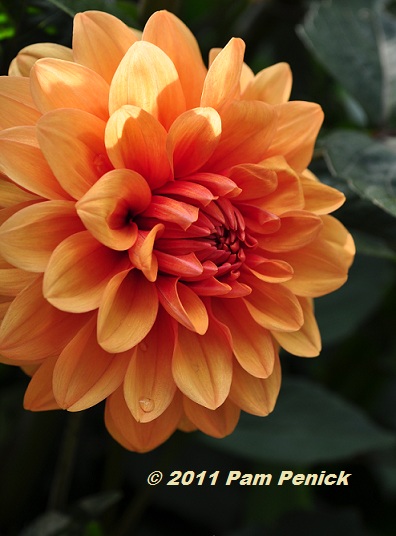
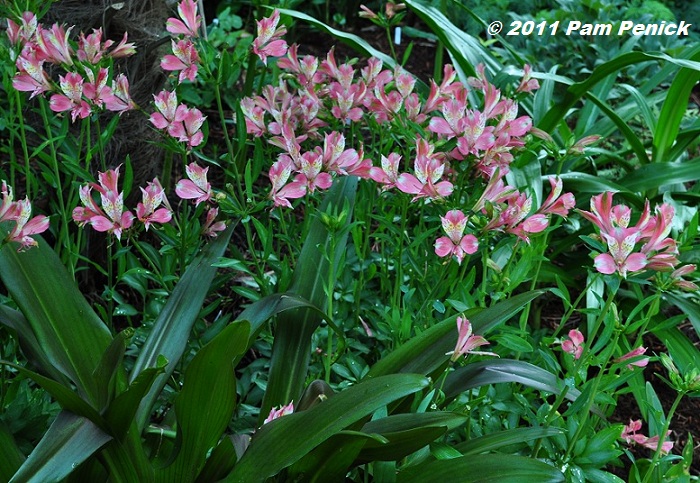
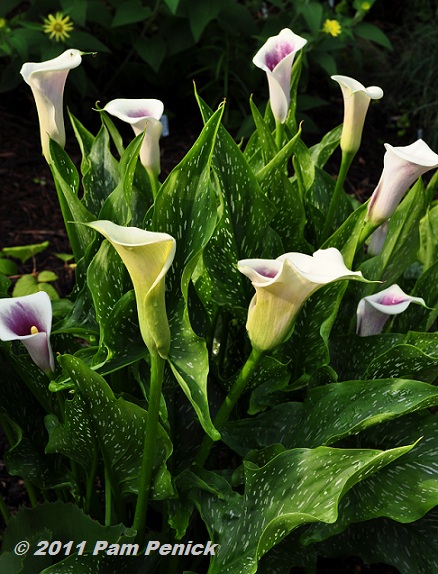
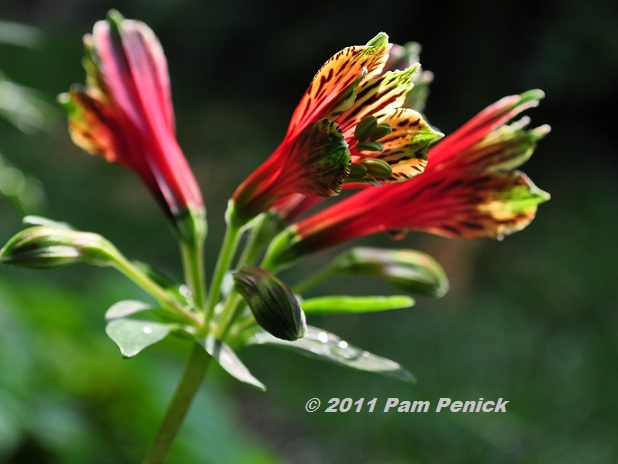
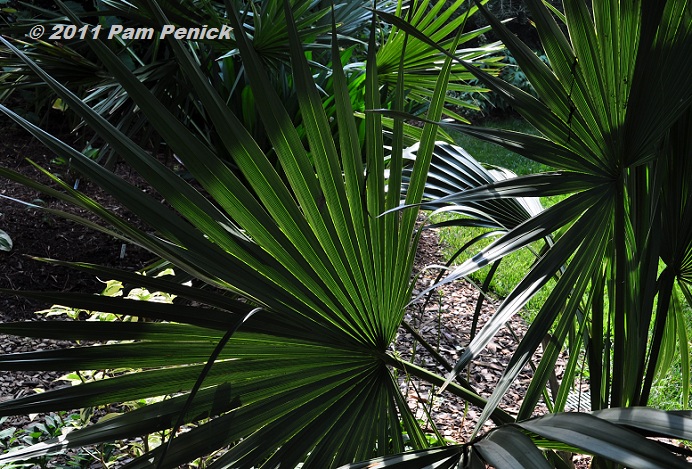
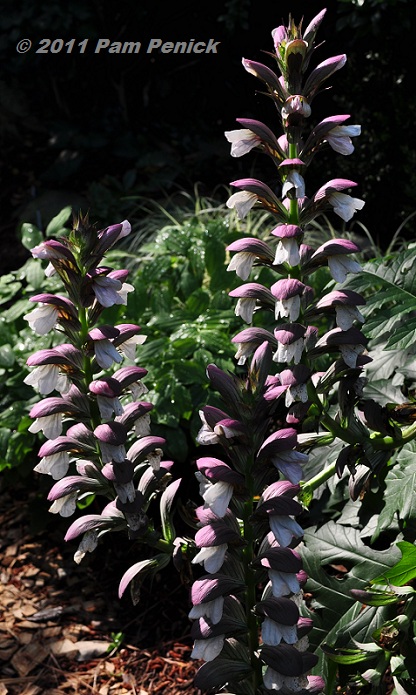
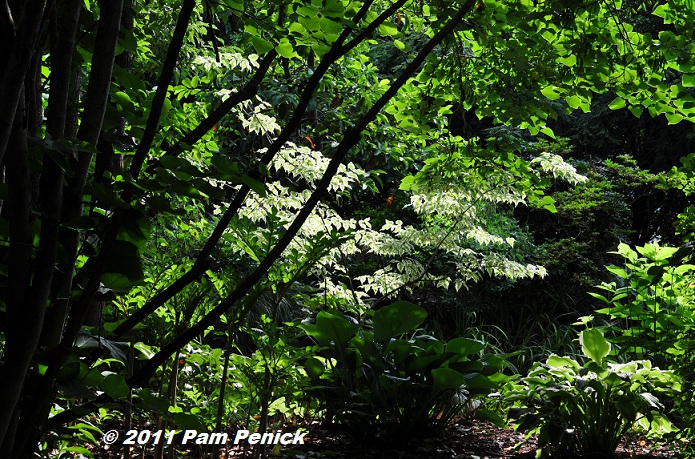
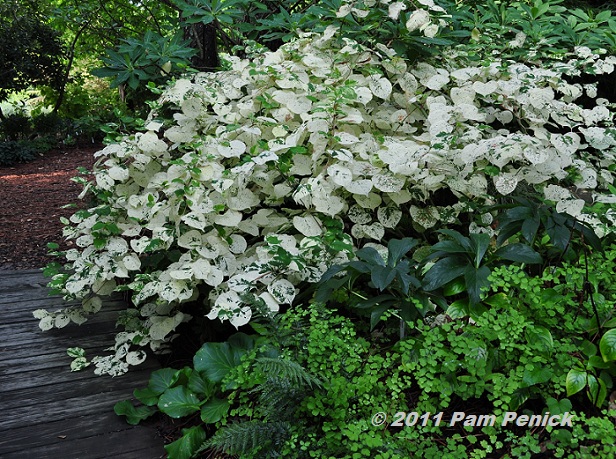

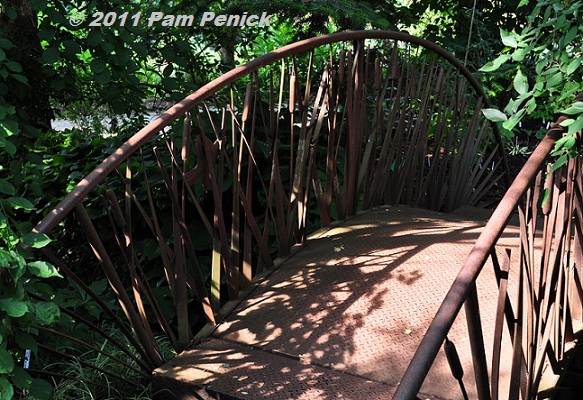
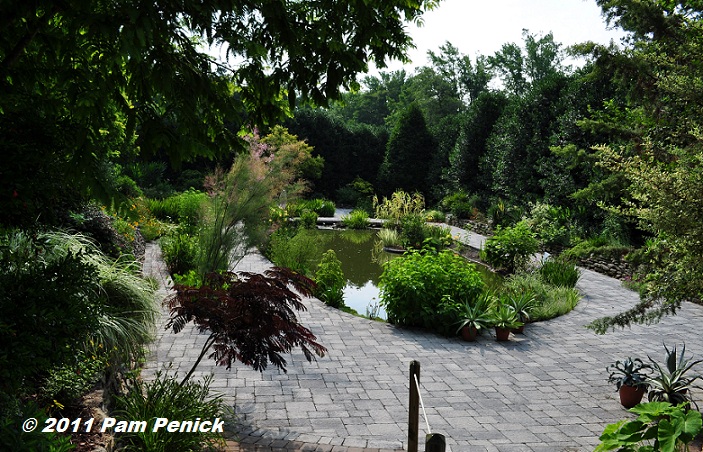
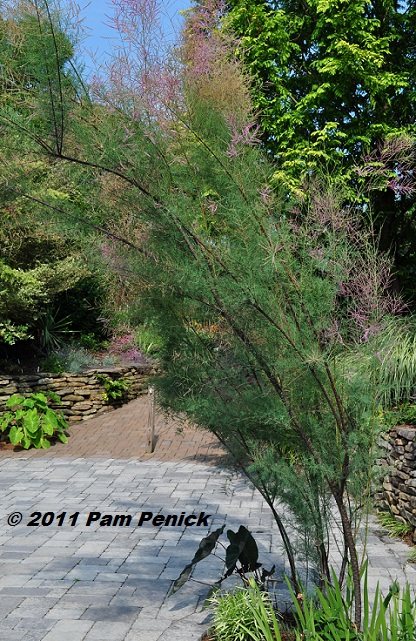
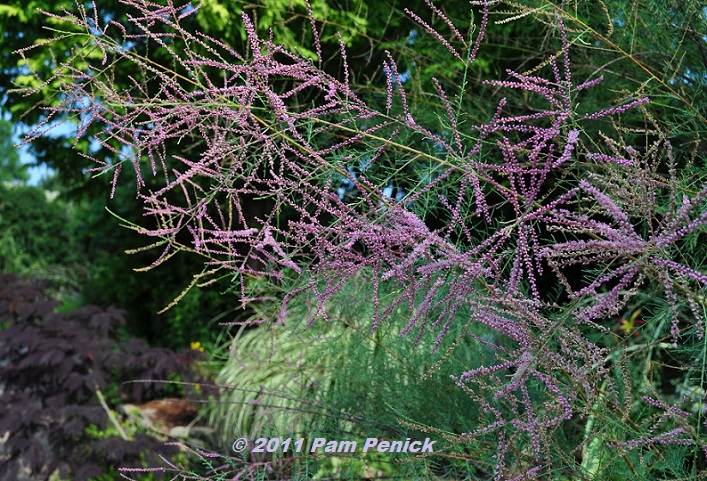
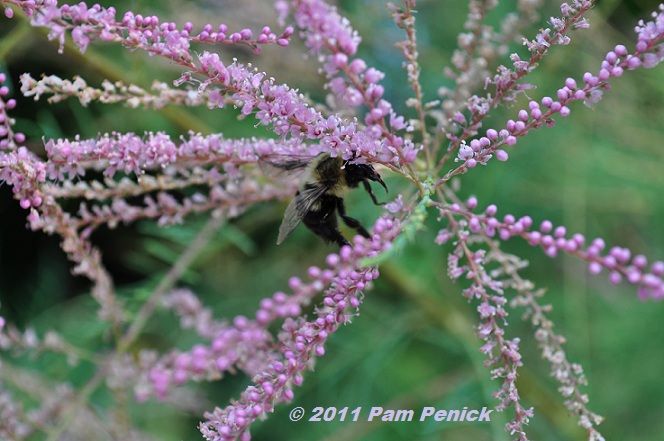
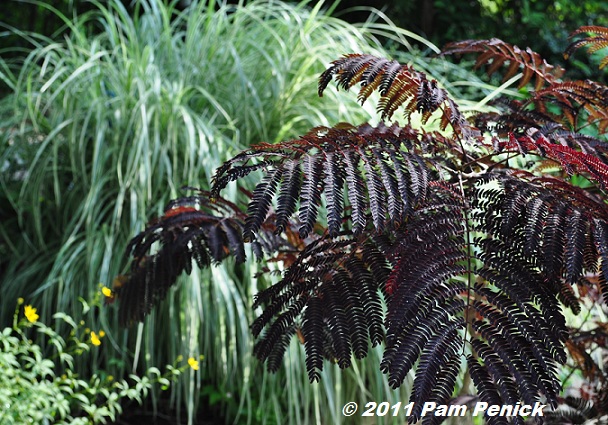
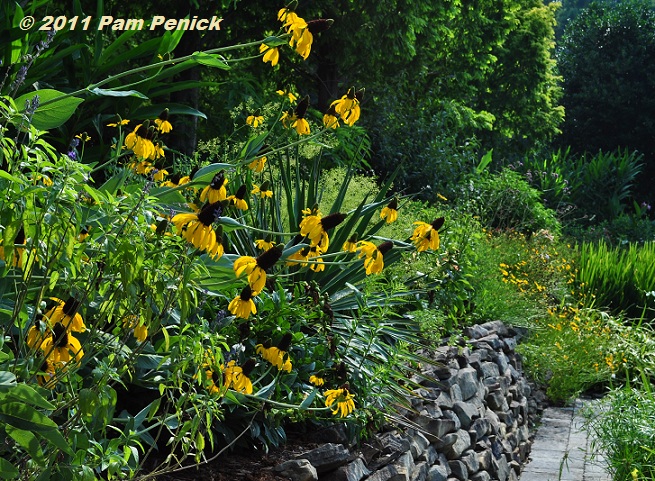
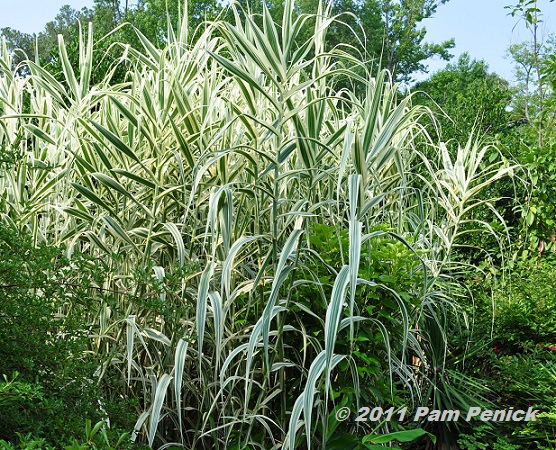
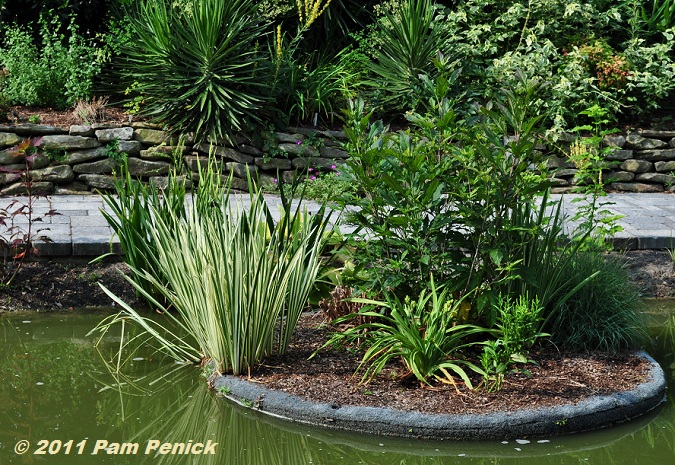
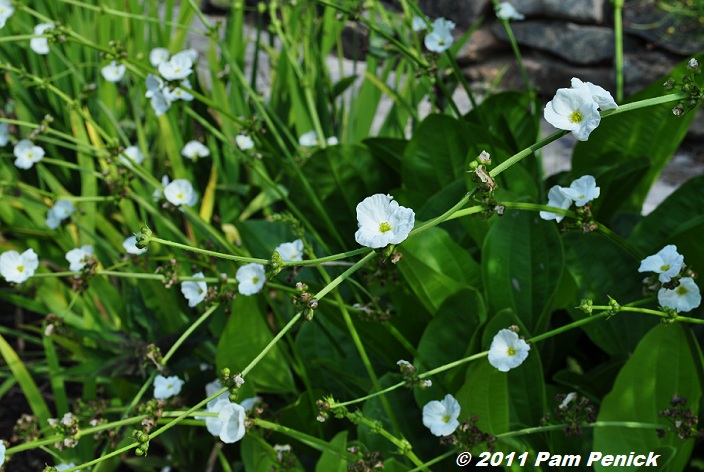
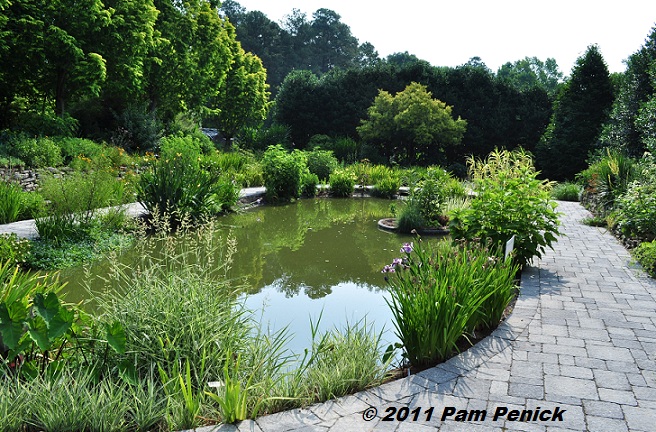
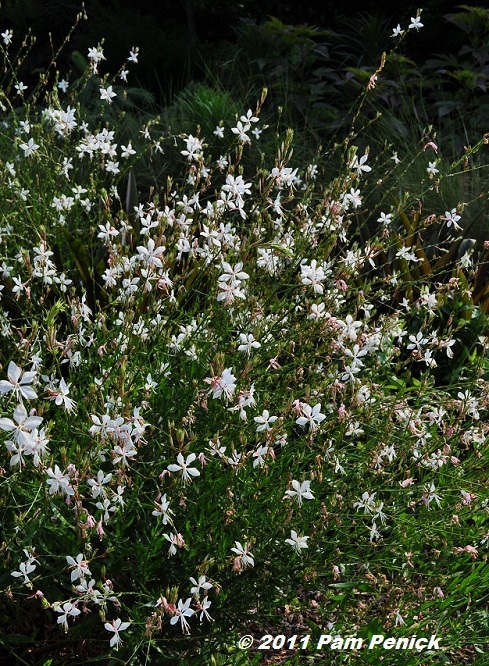
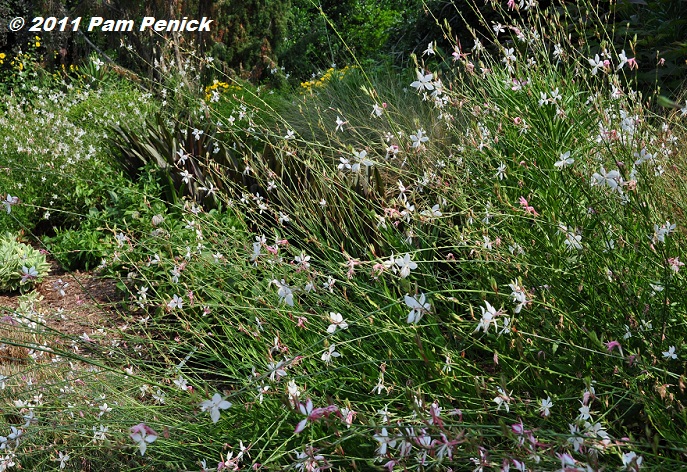
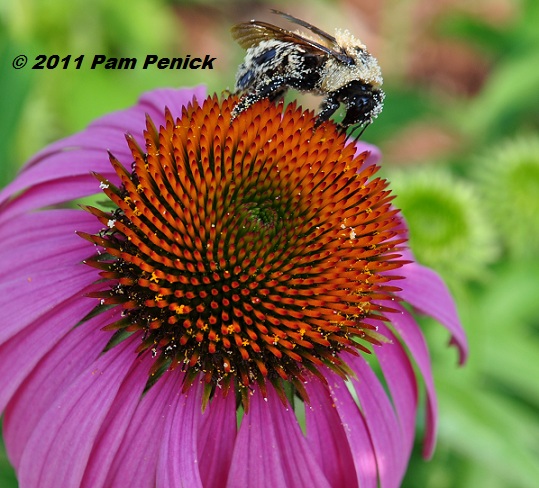
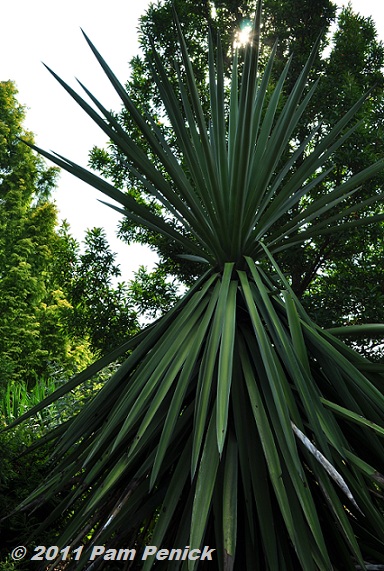
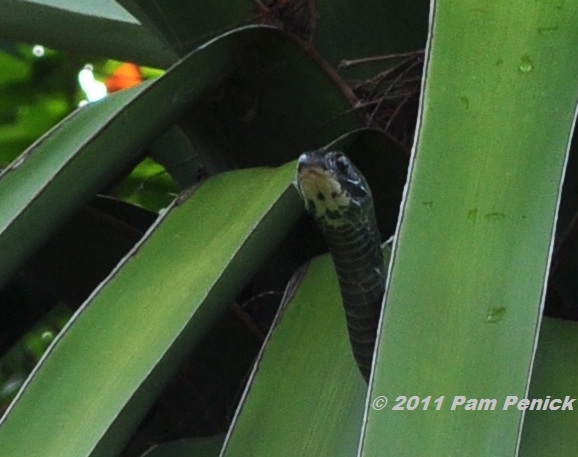
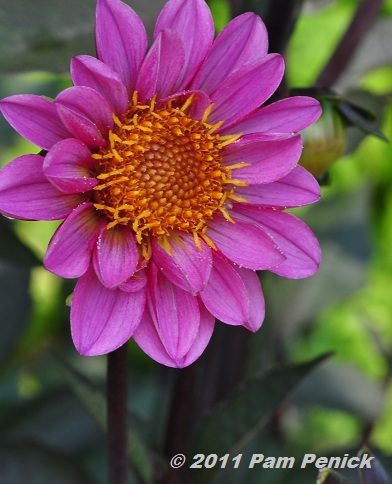
Great looking garden! The one you didn’t know, red and green flower, is Alstroemeria psittacina, or Parrot Flower. I got some of them from one of my plant friends back when I was a kid, and they still flourish at my parents’ house. Unfortunately, not so flourishing here – I think they don’t like our alkaline soil.
Thanks for the ID, Michael. It figures they wouldn’t like our alkaline soil. Maybe a pot would be the way to go? —Pam
What beautiful gardens and man is that a great pond! Your unknown is Alstroemeria. Someone that linked to Bloomin’ Tuesday today posted a Century plant just about to bloom, I thought of you right away. I’ll go and try to get the link for you.
Thanks for the ID, Darla! —Pam
http://savannahgranny.blogspot.com/2011/06/once-upon-century.html hope you get to see it..
Thanks for the link, Darla. Those agave blooms are always incredible to see, but I wouldn’t have expected to see one in Savannah. —Pam
Lovely images, Pam. (Except for the yucca-climbing snake. I’m a wimp!)
We stood under that yucca for a while and debated whether the snake was real, Joey. It held so still that we weren’t sure at first and of course were too far below it to get a good look. I was convinced it was real, however, and once I could look at my pictures on the computer I was even more certain. It sure wasn’t afraid of us. Guess it knew we weren’t yucca climbers. —Pam
The wildlife seems to like this garden too.
You wouldn’t believe the bird song, Lisa, especially in the wooded garden that I’ll be posting pics of next. —Pam
Beautiful. This must be a big place.
Looking forward to the next post.
5 acres, Linda. Tony says on his website that the online nursery business is to support the botanic gardens, which he hopes to arrange the preservation of after he’s gone. —Pam
Thanks so much, Pam! Although I still hope to see Plant Delights in person someday, your photos make me feel as if I’ve been there in a dream. My ‘Fred Howard’ amarcrinum came from PD – it’s in bloom this week so I was already thinking of Tony Avent.
The leaves on the white-with-green tree have a shape like a redbud… maybe it’s one of the variegated types like ‘Floating Clouds’.
Annie at the Transplantable Rose
I have a few of Tony’s plants too, Annie. He has so many more tempting ones, doesn’t he? —Pam
More fabulous pictures! I hope you didn’t have to get too close to the snake though…
Not that one, Loree; it was too high in the yucca. But we did see a LOT of snakes at close range on this vacation, including a rattlesnake and several kinds of water snakes. —Pam
You did a great job of capturing the ambiance of the gardens! Gorgeous photos.
Thanks, Cameron. I was lucky to have such understanding relatives with me, and patient kids. They gave me a lot of time to wander and photograph. —Pam
Oh Man! That snake would have done me in!brrrrrrrrrrrrrrr!! My Alstroemeria psittacina is beautiful this year. Now that DOEreen is gone (RIP)and her doeling hasn’t yet discovered their tastiness, I’m getting quite a show of flowers. Also have Acanthus mollis bloom stalks at least 6′ tall. there are other Acanthus plants scattered around but this one, next to the house seems happiest.
DOEreen—ha! How wonderful to have Acanthus in bloom, Weeder. I have one in my garden, but they melt back to the ground in summer in our climate, only to reemerge in the colder months, with an early spring bloom if we’re lucky. —Pam
Wow, gorgeous. Plant Delights has long been my favorite mail order catalog; now I can see why! I’d love to visit there, and your post makes me want to go even more. How I wish I’d known about it on previous trips to that area. Great post.
Well, Robin, I used to live in Raleigh and didn’t know about it then either. My visit was long overdue. Hope you get to visit one of these days. —Pam
Gnarly! Including the Salt Cedar…invasive out here. I’ve been trying to eradicate the Salt Cedar in the arroyo bordering this property for 5-6 years. I like the plant mix and more tropical feel in those spaces, or at least wetter feel.
That salt cedar is so gorgeous! Too bad it’s so invasive in your climate. Wonder what it does in Austin? —Pam
Don’t like snakes at all. Same thing happened to me once when I was fishing, except it was a water moccasin. If it would have happened today, I would have had a stroke. lol Nice tour, his newsletters are hysterical and enlightening.
A water moccasin is a whole different ballgame, but this little guy looked non-venomous. Still, I’m glad he was “out of range.” —Pam
Happy Summer!
I am rather envious seeing dahlias in bloom. It is a little early here in the Pacific Northwest to find them blooming, although I do see that one of mine has one bud….a yellow one, I think.
You have reminded me how pretty guaras look in the garden. I think one is definitely going to go into my garden this summer. I love the way the airy blooms soar above the plant and move with the breeze.
The bumble bee heavy with pollen made me smile. I have so many bees, including several kinds of bumblers that do the same, and it is always so fun hearing them buzz and bumble around.
Yael
It sounds like you have a lot going on in your garden, Yael. Enjoy, and thanks for your comment! —Pam
Your images of agaves, yuccas and flowers make me want to head right over for a visit. How do they keep their plants looking so gorgeous. Clearly agaves and other desert plants do better where the temperatures are more moderate. They are to be congratulated for their skill at design and plant care.
They have a team of gardeners working in the gardens all the time, so I’m sure that helps, Jenny. They also water, and Raleigh was getting lots of rain while I was there. That’s why they need the berms, I’m sure, but the agaves do enjoy the extra water in summer so long as they have good drainage. —Pam
Thanks for posting these lovely photos from PDN. Those of us who live close to Tony’s place (I live about 3 miles away) appreciate being so close (well, my bank account doesn’t appreciate it, but my gardens sure do!), but it is always great to see his gardens through the eyes of visitors. There were even a few plants that you posted that I haven’t noticed there, so I plan to seek them out during their open house in a couple of weeks! The bumblebee on the coneflower is an amazing shot…simply stunning!
Lucky you to live so close, Judy! I’m quite envious to think of you being able to visit throughout the year in various seasons. —Pam
Beautiful photos as always! Did anyone ID the snake? It looks non-poisonous with its narrow head.
The oval pond looks so tranquil. The floating filtration system is a nice touch too! It looks like a foam base?
No one has ID’d the snake for me, Adam. I agree that it does look non-venomous. We saw at least one venomous snake on our trip though—a rattlesnake. I’ll post pics in a few days. As for the filtration system, I’m not sure what the base was made of, but I believe it was somewhat permeable so that the plants’ roots could do the filtering. —Pam